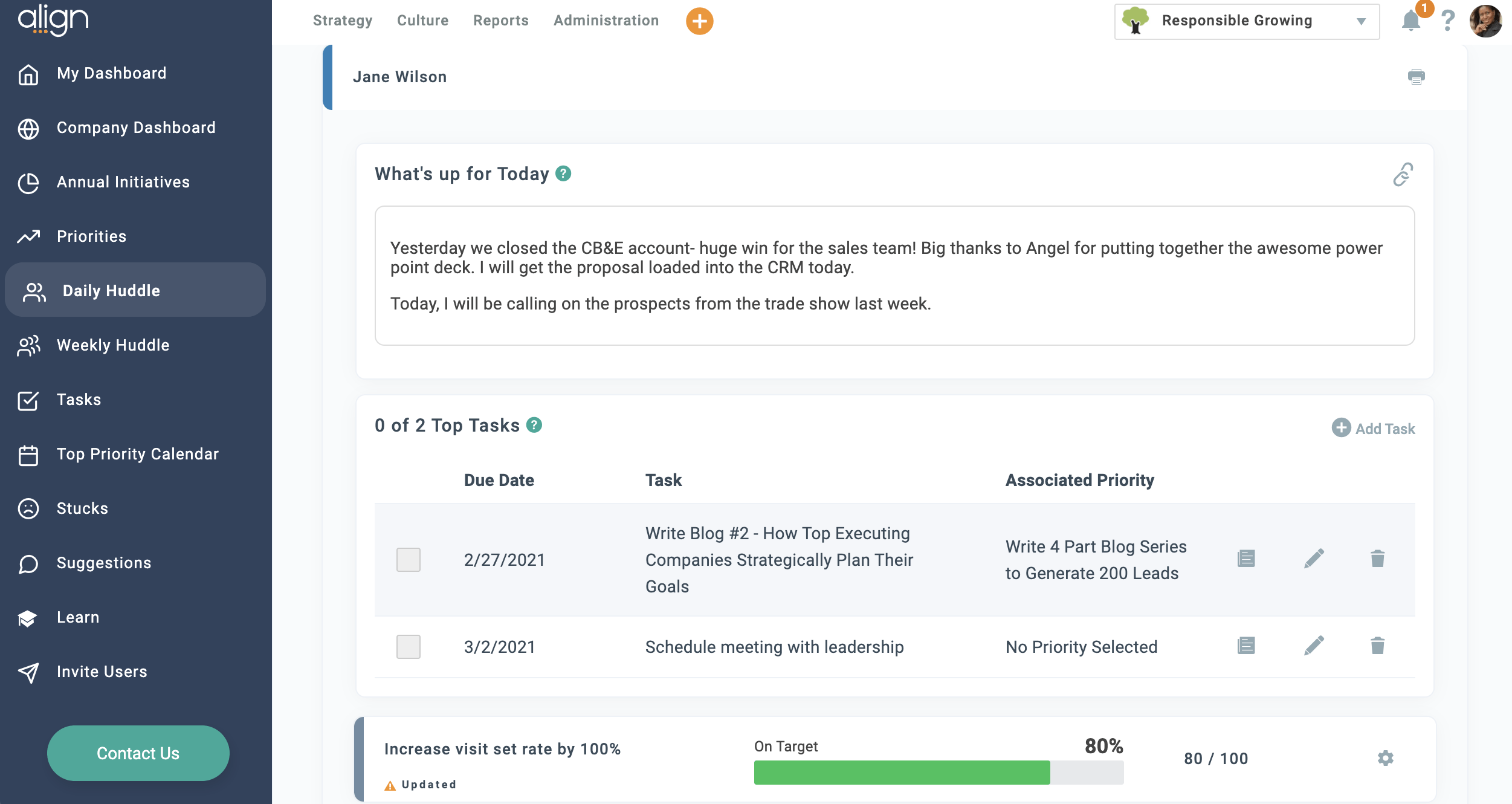How to Use OKRs for Continuous Performance Management
If you’re frustrated with your current performance appraisal system, Objectives and Key Results (OKRs) can help.
Popularized by John Doerr at Google and Kleiner-Perkins, OKRs have helped countless businesses achieve transformative results. But how can OKRs help managers assess and reward performance?
When used correctly, Objectives and Key Results can push your team to achieve and innovate more. In contrast to the Management by Objectives approach, OKRs are aspirational and acceptable at the 60-70% level. Therefore, while OKRs can help augment a continuous approach to performance management, they require a unique approach.
Let’s break down the best practices for teams looking to incorporate OKRs into their performance review process.
Measuring Performance with Objectives and Key Results
Tying performance to measurable goals is critical for a fair and objective appraisal process. An employee who makes significant progress on their Key Results in a quarter is probably a high performer. But should they be a substitute for annual performance goals?
Rather than use OKRs as the staple of annual performance reviews and promotion decisions, OKRs work best when continuously managed. OKRs are dynamic and aspirational. They can change as quarters move along to incorporate new information. They allow for a process of continuous refinement and improvement.
This adaptability over time means frequent discussion on objectives is key. OKRs are not performance benchmarks assessed annually or semi-annually. They are a living blueprint for the direction of the organization and the collective efforts of every individual.
OKRs can be seen as a cornerstone of performance management, but not the whole building. They help shape the direction of innovation in an organization but do not fully represent an individual’s contributions. Performance management can start with a discussion of OKR performance but should also delve into other areas: non-OKR task completion, relationships with team members, and long-term career goals.
OKRs are effective as a tool of performance management because their frequent review and aspirational nature inspire engagement and foster creativity. They help assess and adjust performance expectations in real-time. As John Doerr explains, “Without frequent status updates, goals slide into irrelevance… At quarter’s end (or worse, year’s end), we’re left with zombie OKRs, on-paper whats, and hows devoid of life or meaning.”
The Pitfalls of Using Objectives and Key Results for Performance Appraisals
While OKRs can help add measurable results to performance expectations, John Doerr and others recommend their separation for a few reasons.
Incentivizing Sandbagging
One key component of OKRs is that their creation is collaborative. With Management by Objectives frameworks, management hands down goals to departments and managers set performance goals for their reports based on these top-level goals. Objectives and Key Results should be the result of brainstorming by managers and their reports in collaboration.
As a result, tying OKRs to performance management can incentivize individuals to set goals that they can be sure they’ll achieve. Ideally, OKRs are achievable at a 60-70% confidence level. If performance appraisal depends on OKR success, employees may understate their potential when setting goals.
If progress is tracking ahead of expectations, employees won’t have an incentive to update OKRs to keep them ambitious. When incorporated into continuous performance management, OKRs help identify top performers while allowing goals to adapt to maintain relevance and ambition.
Reducing Creativity
OKRs foster creativity by setting objectives beyond the current capacity of the organization. An objective like “Become the industry leader in customer satisfaction” implies that:
- your organization is not currently the industry leader
- new processes and ideas are required to elevate current performance
A focus on goal completion may distract from the underlying motivation for the objective in a performance management context.
Limiting Collaboration
OKRs align an organization behind its most critical areas of strategic focus. They work by rolling up individual objectives into the team and organization-wide goals.
In many organizations, employees may feel, rightly or not, that they are competing with teammates for raises and promotions. Tying OKRs to performance appraisals can create a focus on individual goals at the expense of team goals. OKRs may effectively incentivize performance but only at the team level.
Should OKR performance affect compensation?
According to John Doerr, the answer is no. “Divorce compensation (both raises and bonuses) from OKRs,” he recommends. “These should be two distinct conversations, with their own cadences and calendars.”
Even if they comprise different workstreams, OKR performance can still be a valuable input of the appraisal process. Someone who continually exceeds expectations as evidenced by OKR performance deserves special recognition in promotion and compensation decisions.
OKRs are useful for performance appraisals because they serve as a record of contributions to innovation and growth. They balance out other inputs like 360 Feedback and non-OKR task performance.
If OKRs are consistently reviewed as part of continuous performance management, every individual should already know where they stand with regards to compensation and promotion. Their success or failure does not determine how managers assess performance. But the innovation and successful improvements over time should help employees advance their career goals.
Performance Reviews vs Conversations, Feedback, Recognition (CFRs)
In contrast to the annual performance review, continuous performance management with OKRs involves what John Doerr calls CFR- conversations, feedback, and recognition.
OKRs can be measurably assessed: was the goal achieved or not? CFR provides the color commentary to the results achieved.
While OKRs may be time-bound, CFRs are the continuous tracking, sharing, and discussion of goal performance. Conversations and Feedback allow managers to coach reports to achieve their results. A core question of these conversations is “What can I do to help?”
Rather than reward or punish performance, these conversations give an opportunity to adjust course in real-time and identify emerging blockers and opportunities. They provide managers a window into how they can help their team achieve peak performance.
Recognition transforms company culture by building team investment in achieving goals. By transparently sharing OKR progress, every member of the organization can celebrate the accomplishments of their peers. When one objective advances, every member of the team can celebrate the progress being made.
Enabling Continuous Performance Management with OKRs
When implementing OKRs in your organization, the right tool can make all the difference. For effective continuous performance management, OKRs need to be centrally tracked and easily communicated.
Align’s OKR software makes this easy by combining OKR progress, outstanding tasks, and regular communication in one easy view.

While there are many choices for OKR software, Align uniquely combines communication, OKR tracking, and long-term planning to power success.
With the right tool, Conversations, feedback, and recognition become an everyday part of getting work done. Assessing goal performance is as easy as looking at a dashboard. Align allows you to add notes to communicate why a key metric is ahead or behind. Easily create a task for anyone in the organization to help move your Key Results along.
Establishing new processes is challenging. That’s what makes OKRs so effective. Organizational alignment requires us to grow creatively and ambitiously. With the right tools in place, your team can achieve a more engaging performance appraisal process while staying focused on what really matters: achieving game-changing results.





